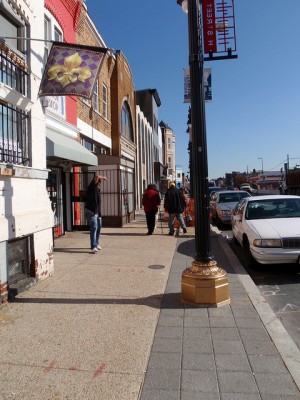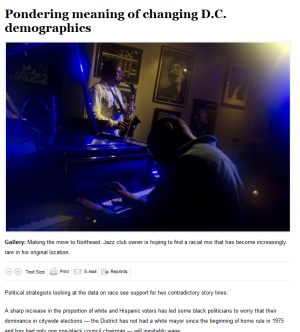April 13, 2011 | 8:58 AM | By Anna
Good morning, DCentric readers! Here are some links for a soggy gray day:
Women Beating Homeless Men For Cash; DC Advocates Fighting It Local advocates for the homeless say fights are being staged for a website which offers videos of homeless men being attacked by “scantily-clad women”. Each man receives between $25-50 for allowing themselves to be hit, but the videos sell for hundreds of dollars. “Recently, the National Coalition for the Homeless, a DC-based organization, obtained a temporary restraining order barring the site’s producers from approaching homeless people.” (wusa9.com)
Treading On D.C. Adam Serwer points out that neither the White House nor Congressional Democrats had the courtesy to alert Mayor Gray that “they were trading away the city’s autonomy to stave off further budget cuts.” And as for those who characterized the Mayor and certain Councilmembers actions as a mere stunt? “Gray getting arrested was a stunt. But stunts are really all the city has to register its displeasure, since it’s not like we have representation in Congress that might be able to make a difference.” (The American Prospect)
Witnessing the DC Rights Protest via Flickr Eyewitness account of a local photographer, who was at the protest: “In general, I tend to dislike political grandstanding… but this was different. If our council was being arrested by our own police, I’d think it a cheesy photo op… but now our locally-elected officials were being arrested by the very forces we were out to protest: the Feds. This wasn’t a mere photo op arrest; this was actually a legitimate arrest… the kind of thing that goes on your record; the kind of thing you spent a night in jail for.” (flickr.com)
Continue reading →

Flickr: The.Comedian
Forbes just came out with its list of top 10 richest counties, and guess what: four of them are in the D.C.-area.
And what isn’t on that list? D.C., of course. The richest jurisdiction is Falls Church, which boasts a median household income of $113,313. According to 2008 U.S. Census Bureau statistics, D.C.’s median household income was $58,553 — which not only falls extremely short of all top 10 counties on the list, but barely exceeds the 2008 national average of $52,029.
From the story:
In recent decades northern Virginia has become an economic dynamo, driven by a private sector that feasts on government contracting. These counties are also home to corporate lobbyists, lawyers and consultants who work in or around the nation’s capital, soaking up federal government spending. And government-related hiring manages to keep the unemployment rate in places like Falls Church City down to 5.7%.
That so many District-based jobs are held by non-District residents has long been a point of contention for D.C. leaders and community organizers, particularly since unemployment ranges from 10 to 15 percent in parts of the city.

Flickr: Daquella Manera
Which side of H Street NE will we see in this new sitcom?
Frozen Tropics alerted us to this open casting call for a sitcom called H-Street, set in the H Street NE corridor. Get ready for some serious plots involving race, gentrification and clashes over streetcars!
Hm, or maybe not so much.
The roles include some male and female characters in their 20s who are all D.C.-transplants. Some are out to save the world, others work on the Hill, and others are completely oblivious of politics and play kickball (!).
No race is specified for those roles, but it is specified for two other characters: a black burglar (really?) who is to be in his late teens or early 20s and can “pull off a terrible British accent” (no idea where that is going), and Charles, a D.C. native who runs a “clean, efficient” bar on H Street NE and is “annoyed by hipsters.” Notably missing is a casting call for said hipsters.
It’s not exactly clear who is behind this self-described low budget, independent project, but we will be watching with baited breath.
Good morning, DCentric readers! While you were out getting arrested for a good cause, we were searching the woolly wide web for links!
Va. teacher holds mock slave auction An elementary school teacher tried to enliven a history lesson by dividing her class by race…so that the white students could buy their black and multi-racial peers. The class is 40 percent white and 40 percent black. “The lesson could have been thought through more carefully, as to not offend her students or put them in an uncomfortable situation,” said Sewells Point Elementary School principal Mary Wrushen, in a letter to parents which was sent last week. The teacher has been with the school for six years; a spokesperson for Norfolk public schools issued a statement indicating that they are taking “appropriate personnel action”. (The Washington Post)
Deanwood Plays Hardball With Liquor Stores Deanwood residents are protesting Uncle Lee’s application for an alcohol license, who say they need to sell booze and lotto tickets to keep their business alive. “The owners of Uncle Lee’s are being stubborn, and maybe they could make a go of it with groceries instead of booze on that high-visibility corner. But with things as they are, the crusade against their right to sell liquor might just end up driving them out of business entirely (which would be a shame for local food options; the crabcake sandwich isn’t bad). That could allow another entrepreneur with more startup capital to buy the place and set up something the locals would like. Or it could result in the corner sitting empty for years to come.” (Washington City Paper)
African-Americans and the White House In case you missed last week’s show, give this interview a listen to get a sense of the history of black Americans and the White House. “The White House is a symbol of American power all over the world. But for many African-Americans, this most famous of American homes also represents a rarely discussed history of exclusion and inequality.” (WAMU/Metro Connection)
Continue reading →
Less than 24 hours have passed since the Washington Post story on the District’s declining black population ran, and already we have a political shake-up of sorts.
The story included comments from Marshall Brown, who is D.C. Council Chairman Kwame Brown’s father and a member of Sekou Biddle’s campaign to keep his At-Large seat on the council. Brown is quoted in the Post story as saying that new white voters in D.C. “believe more in their dogs than they do in people. They go into their little cafes, go out and throw their snowballs. This is not the District I knew. There’s no relationship with the black community; they don’t connect at church, they don’t go to the same cafes, they don’t volunteer in the neighborhood school, and a lot of longtime black residents feel threatened.”
Were those comments reflective of how Biddle feels? He issued this statement late this afternoon:
The District of Columbia is a better city because of our growing diversity. While change can be difficult and at times uncomfortable, these kinds of comments are hurtful. My wife and I choose to raise our children here because of the diversity the city has to offer. Marshall Brown does not speak for me or my campaign and his comments in Marc Fisher’s story do not help move our city forward. While he is a longtime family friend, I found his comments to be counterproductive at a time when I am working so hard to bring people in this city together and I have asked him to step down from any future involvement in my campaign.
There’s much to be discussed about today’s Washington Post story on the meaning of D.C.’s changing demographics. But aside from the heated comments on gentrification — which even spurred a bingo card – comes this comment on the actual story, from poster gardyloo:
What stories on the census don’t discuss is how many of the 300,000 Washingtonians identify as African Americans because they are immigrants from Africa, or children of immigrants from Africa. That number is probably as high as ten percent of the overall total of African Americans here now. Their story is, for the most part, the immigrant story, the story of a search for opportunity and a better life. They aren’t weighed down by the city’s history and golden-age thinking.

Screenshot of Washingtonpost.com
The Washington Post ran a story on D.C.'s changing demographics.
We’re not sure exactly where those particular figures come from (perhaps they refer to the African population in the entire D.C.-metro area, which numbers as 150,000 strong). But if we look at the most recent Census estimates, the District had about 74,000 foreign born residents in 2009. Of those, about 18,000 are black immigrants from African and Caribbean countries — accounting for 24 percent of all immigrants here in the District. Those numbers obviously don’t include the U.S.-born children of these immigrants, but they do speak to a sizable population of folks in D.C. who may check “black or African-American” on a Census form but perhaps don’t identify first and foremost with the American black experience.
Your tasty morning bytes are a bit late, but worth a read nonetheless:
Pondering meaning of changing D.C. demographics Sure, D.C. may no longer be a majority-black city, but does that mean the District’s culture and identity has changed dramatically as well? “… Tom Lindenfeld, chief strategist for Adrian M. Fenty’s successful 2006 mayoral campaign, isn’t so sure. The fact that the percentage of blacks is waning isn’t the issue, he says. It’s the attitude of the whites coming in. ‘A lot of younger, more transient white people who live in D.C. still identify with where they came from and often still vote back there,’ he said. ‘Whereas many black people identify with the District and local issues.’” More on this one later… (Washington Post)
D.C. Mayor Decries Congressional Budget Deal Congress came to a compromise to prevent a federal government shutdown, but included D.C.-specific provisions. “It was ‘shocking,’ Gray said of the deal, which includes prohibitions on District funding for abortions and a reinstatement of a school voucher program. The final legislation being drafted this week may also prevent D.C. from funding a needle-exchange program.” (WAMU)
Continue reading →
In responding to a Wall Street Journal story about how white children are now the minority in many states as the number of Hispanic children grows, D.C.’s Matthew Yglesias writes:
I think this is a widely misreported trend. When the New York Times recently did a piece on me, Ezra Klein, Brian Beutler, and Dave Weigel exactly zero people complained about the massive over-representation of people of Latin American ancestry that reflected. People saw it as a profile of four white dudes. Which is what it was. But my dad’s family is from Cuba, Ezra’s dad’s family is from Brazil, and Brian’s mom’s family is from Chile. That’s kind of a funny coincidence, but the combination of continued immigration and intermarriage means that over time a larger and larger share of American people will be partially descended from Latin American countries.

The New York Times profiles four (white) pundits.
That Times piece on Yglesias and his fellow, young pundits did receive plenty of criticism (and even its own parody!). But Yglesias is right: no one criticized the over-representation of Latin American-ancestry among the four subjects. The reporter behind the piece even commented on the “white maleness” of the story.
When it comes to Latinos and Hispanics, racial identity has proven to be a much more fluid thing than for other groups. For instance, let’s take a look at Latino immigrants: a 2010 American Sociological Association report found that there are many Latino immigrants who are accepted as white by larger society, but those with darker complexions still face plenty of discrimination. It even suggested a new racial category to describe Latinos could form.
Continue reading →
For the 2nd time in 5 months, fmr. gov. and sen candidate George Allen asks me,"what position did you play?" I did not a play a sport. Craig Melvin is a tall, black man. Oh, and he happens to be an NBC4 reporter.
Former governor George Allen later tweeted an explanation:
.@ sorry if I offended, ask people a lot if they played sports Grew up in football family found sports banter good way to connect Perhaps Allen reminding Melvin of his football roots isn’t the best tactic, though.










